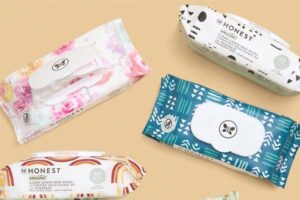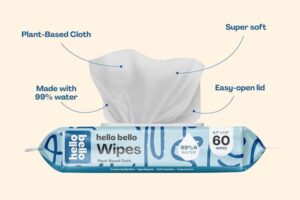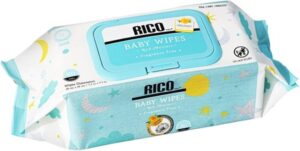
Choosing baby wipes can feel overwhelming. You worry about delicate skin and confusing labels. I'm here to clarify which materials truly offer the best combination of gentleness, effectiveness, and safety for babies.
The "best" baby wipe material is soft, strong, absorbent, and most importantly, safe for sensitive skin. Natural fibers like 100% organic cotton1 and plant-derived options such as bamboo viscose2 are excellent choices due to their gentle properties and sustainability.
Selecting the ideal material isn't about finding a single perfect answer. It really depends on what matters most for your specific needs and your customers. Factors like the baby's skin sensitivity are paramount – some babies react easily to even mild irritants. Your brand's environmental values also play a big role; maybe compostability is key. And of course, the wipe needs to perform well. It must be strong enough for effective cleaning without falling apart, yet soft enough not to cause irritation. Budget considerations naturally fit into this equation too.
So, when we talk about "best," it's a balance. For newborns or babies with conditions like eczema, the absolute softest, most hypoallergenic material, often organic cotton, is preferred. If reducing environmental impact is a top priority for your brand, then materials sourced from rapidly renewable resources like bamboo, or certified biodegradable options like plant-based PLA, become leading contenders. We also pay close attention to how the material holds and releases the cleansing solution – it needs to be effective from the first wipe to the last.
Why is Choosing the Right Material So Important?

Picking the right wipe material goes far beyond just the feel. This choice directly impacts a baby’s health, overall comfort, and even the environment.
Choosing the right material is crucial because it directly touches a baby's delicate skin, potentially preventing irritation or allergic reactions. It also determines the wipe's cleaning performance – its strength and absorbency – and significantly impacts its environmental footprint after use.
Let's dive deeper into why this selection matters so much:
Protecting Delicate Baby Skin
A baby's skin barrier is much thinner and more sensitive than an adult's. This makes it prone to dryness, irritation, and reactions.
- Texture Matters: Rough materials can cause friction and redness. We prioritize ultra-soft fibers like organic cotton or specially processed bamboo.
- Chemical Sensitivities: Some materials require chemical processing. We ensure our materials, like our organic cotton or PLA options, are free from harsh residues. Our formulations are always alcohol-free and hypoallergenic.
- Purity is Key: We focus on materials that are inherently pure and less likely to harbor irritants. Our quality control includes rigorous screening for contaminants (ISO 11737-1 microbial screening).
Choosing a material like our certified organic cotton minimizes the risk of immediate skin reactions and contributes to the baby's long-term skin health. This is vital for brands targeting parents who prioritize safety and natural ingredients, like our client Emily Thompson in the US healthcare sector looking for validated, gentle products.
Environmental Responsibility
The sheer volume of baby wipes used globally creates significant waste. Material choice is central to addressing this.
- The Plastic Problem: Many conventional wipes contain plastic fibers (like polyester or polypropylene) that do not break down, contributing to landfill burden and microplastic pollution.
- Biodegradable Alternatives: We champion materials like bamboo viscose and PLA non-wovens which are plant-based and designed to biodegrade under specific conditions. Our compostable options offer a certified end-of-life solution (12-month degradation guarantee for compostable sachets).
- Sustainable Sourcing: It's not just about biodegradability, but also responsible sourcing. We use FSC-certified packaging and prioritize materials from sustainable sources, aligning with the values of clients like Henrik Sørensen who demands Cradle-to-Cradle certified options.
Offering wipes made from eco-conscious materials allows brands to meet growing consumer demand for sustainability and differentiate themselves in the market.
Ensuring Performance and Durability
A wipe needs to work effectively. The material composition dictates its functional properties.
- Strength: Wipes must withstand stretching and scrubbing without tearing. We test tensile strength (ASTM D5034) to ensure durability. Materials like bamboo offer excellent natural strength.
- Absorbency: The material needs to hold enough liquid solution to clean effectively but release it properly onto the skin. Our material selection and AquaRise® technology optimize liquid retention (using 30% less liquid with 99.9% efficacy).
- Softness: While strong, the wipe must remain soft. We balance fiber types and processing methods to achieve the desired softness without compromising strength.
A wipe that performs poorly frustrates parents and reflects badly on the brand. Our focus on material science ensures a positive user experience.
What are Popular Baby Wipe Material Options?
Now let's look at the specific materials commonly used in baby wipes. Each one offers a unique set of characteristics. Understanding these helps you make an informed choice.
Popular baby wipe materials include gentle and absorbent organic cotton, strong and sustainable bamboo viscose, biodegradable plant-based fibers3 (like PLA), and sometimes specific synthetic blends designed for enhanced stretch or durability, though natural fibers are often preferred.
Here’s a closer look at the most common choices we work with:
100% Organic Cotton
- Pros: Exceptionally soft, highly absorbent, naturally hypoallergenic, breathable, biodegradable. Ideal for the most sensitive skin. Preferred by eco-luxury brands like Luca Moretti's.
- Cons: Can be more expensive than other options, may not be as strong as some blends unless processed carefully.
- Best For: Premium baby care lines, sensitive skin formulations, brands emphasizing natural purity.
Bamboo Viscose
- Pros: Very soft (often compared to silk), strong and durable, highly absorbent, naturally hypoallergenic and antimicrobial properties, resource grows rapidly. Biodegradable.
- Cons: Processing rayon/viscose can involve chemicals (though greener methods exist, which we prioritize), generally costs more than synthetics but less than organic cotton.
- Best For: Eco-conscious brands looking for a balance of performance, sustainability, and softness.
Plant-Based PLA (Polylactic Acid)
- Pros: Made from renewable resources (corn starch, sugarcane), commercially compostable and biodegradable, performs well in terms of strength and liquid handling. A good modern eco-option.
- Cons: Can sometimes be slightly less soft than cotton or bamboo initially (though technology is improving), requires industrial composting facilities for Breakdown. Represents innovative tech sought by clients like Priya Kapoor.
- Best For: Brands focused on cutting-edge sustainable solutions and certified compostability.
Material Blends
- Purpose: Sometimes fibers are blended (e.g., cotton with PLA, or bamboo with Tencel™/Lyocell) to achieve specific properties, like improved stretch, enhanced softness, or optimized cost.
- Caution: Be mindful of blends containing non-biodegradable synthetics like polyester (PET) or polypropylene (PP) if sustainability is a key goal. We generally steer clear of these for our premium baby lines unless a specific performance target demands it, and always with full transparency.
Here's a quick comparison table:
| Feature | Organic Cotton | Bamboo Viscose | Plant-Based PLA | Typical Synthetics (PET/PP) |
|---|---|---|---|---|
| Softness | Very High | High | Moderate-High | Moderate-Low |
| Strength | Moderate | High | High | Very High |
| Absorbency | High | Very High | High | Moderate |
| Hypoallergenic | Yes | Yes | Yes | Generally Yes |
| Biodegradable | Yes | Yes | Yes (Compostable) | No |
| Sustainability | High (Organic) | High (Renewable) | High (Renewable) | Low (Fossil Fuel based) |
| Cost | Higher | Moderate-High | Moderate | Lower |
How Do Material Choices Affect Cost and Performance?

The material you choose isn't just about features for the baby; it directly impacts your product's final cost and how well it actually functions day-to-day.
Material selection directly influences manufacturing costs through raw material pricing and processing needs. It also dictates essential performance aspects like the wipe's softness, resistance to tearing during use, and how effectively it holds and delivers the cleaning solution.
Let's break down this connection further:
Cost Implications
- Raw Material Price: This is often the biggest factor. Organic cotton typically costs more than conventional cotton or bamboo, which in turn cost more than basic synthetic fibers. Plant-based PLA falls somewhere in the middle range.
- Processing Complexity: Delicate natural fibers might require slower production speeds or specialized handling, potentially increasing manufacturing costs compared to robust synthetics.
- Minimum Order Quantities (MOQs): Sourcing specialized sustainable materials sometimes involves higher MOQs from suppliers, which can be a factor for startups like Priya Kapoor's. At BBWIPES, we offer flexibility (10k units for stock, 50k for custom formulations) to help manage this.
Performance Trade-offs
There's often give-and-take between different desirable qualities:
- Softness vs. Strength: Extremely soft fibers might naturally have lower tensile strength. We engineer our nonwovens like carefully spun bamboo to maximize softness without sacrificing necessary durability.
- Absorbency vs. Dispensing: Highly absorbent materials are great but need to release the liquid effectively when wiped. The material structure influences this balance.
- Thickness vs. Count: Thicker, more luxurious-feeling wipes use more material per wipe, impacting cost per pack and the number of wipes that fit in standard packaging.
Formulation Compatibility
The wipe material must work seamlessly with the liquid solution (lotion) it carries.
- Absorption Dynamics: Different fibers absorb and hold liquids differently. Some might absorb too slowly, others might not release the liquid adequately.
- Ingredient Interaction: The material should not react negatively with lotion ingredients (e.g., causing discoloration or degradation). This is crucial for sensitive formulations or those with active ingredients like the CBD wipes Priya Kapoor orders. We conduct free compatibility testing (3 prototype iterations included) to ensure stability.
Our R&D team specializes in matching the right material substrate with your chosen formulation to guarantee optimal performance and shelf-life (36-month assurance).
Are Eco-Friendly and Biodegradable Materials Really Better?
With growing consumer awareness, "eco-friendly" is a major selling point. But when it comes to baby wipes, is this trend truly better, and what should you look for?
Yes, materials like bamboo, organic cotton, and PLA are generally better for the environment because they derive from renewable resources and can break down, unlike plastic-based wipes. However, claims need validation through reliable certifications to avoid greenwashing pitfalls.
Let's clarify what makes a material genuinely eco-conscious:
Understanding the Terms: Biodegradable vs. Compostable
These terms are often used interchangeably, but they differ:
- Biodegradable: Means the material can be broken down by microorganisms over time. The conditions (temperature, moisture, microbes) and timeframe aren't always specified. Many things will eventually biodegrade, but it could take years.
- Compostable: A more specific term. Means the material can break down relatively quickly into non-toxic components (humus) under controlled composting conditions (industrial or sometimes home). This requires certification (like EN 13432 in Europe or ASTM D6400 in the US).
We offer materials certified for compostability, ensuring they meet rigorous standards for disintegration and eco-toxicity, crucial for brands targeting sustainability advocates like Henrik Sørensen.
Key Certifications to Verify Claims
Don't just take a supplier's word for it. Look for third-party validation:
- Material Source: FSC (Forest Stewardship Council) for wood pulp/bamboo ensures responsible forestry. GOTS (Global Organic Textile Standard) for organic cotton verifies origin and processing.
- Compostability: Certifications like TÜV Austria OK compost (Industrial or Home), BPI (North America), or Din Certco prove the material meets standards.
- Overall Impact: EU Ecolabel looks at the product's entire lifecycle.
- Safety/Ethics: OEKO-TEX Standard 100 (tests for harmful substances), Leaping Bunny (cruelty-free).
We hold multiple certifications (ISO, GMP, FDA/EU compliance, FSC sourcing, Leaping Bunny) and provide transparency about our materials.
Avoiding the Greenwashing Trap
"Eco-friendly," "earth-friendly," or "natural" can be vague marketing terms without proof.
- Ask for Specifics: What exactly makes it eco-friendly? Is it the material, the sourcing, the packaging, the carbon footprint?
- Request Documentation: Ask for copies of relevant certifications.
- Consider the Whole Package: Is the packaging also recyclable or compostable?
True sustainability involves transparency and verified claims. We provide sustainability reporting and carbon footprint analytics to back up our eco-conscious commitments.
Why Partner with BBWIPES for Your Baby Wipes?
Choosing the right material is a critical first step. Partnering with an experienced and capable manufacturer is essential to bring your vision to life effectively and reliably. At BBWIPES, we combine material expertise with end-to-end manufacturing capabilities.
With over 12 years specializing in premium wet wipes, we understand the nuances of material selection and formulation. We operate from our ISO 9001, GMP, and ISO 22716-certified facility in Wenzhou, China, ensuring international quality standards.
Here’s why brands worldwide trust us:
- Deep Customization Expertise: We guide you through material choices – from 100% organic cotton and sustainable bamboo to advanced PLA non-wovens. Our R&D labs develop custom, alcohol-free, hypoallergenic solutions tailored to your needs, including specialized options like CBD-infusion or EN 14476-certified virucidal wipes.
- Uncompromising Quality Assurance: Our 4-Stage Inspection Protocol (raw material screening, in-line monitoring, strength validation, seal integrity testing) guarantees consistency and safety, batch after batch. We meet stringent global standards (FDA 21 CFR, EU Ecolabel, REACH).
- Proven Eco-Conscious Innovation: We lead with solutions like our AquaRise® technology (reducing liquid use by 30%) and offer certified compostable materials and packaging options (FSC-certified sourcing).
- Agile & Reliable Global Logistics: We ensure product integrity with temperature-controlled shipping and offer efficient lead times (12-day standard, 7-day express available) with flexible terms (DDP/DAP). Our 36-month shelf-life assurance gives peace of mind.
- Regulatory Mastery & Support: We navigate complex regulations (EU Cosmetics Regulation 1223/2009, US EPA criteria) and provide documentation like GHS-compliant SDS. Benefit from flexible MOQs (stock from 10k, custom from 50k units), free compatibility testing, and 24/7 lab support.
We have successfully partnered with diverse clients, from French luxury hotels needing bespoke facial wipes to US pediatric hospitals requiring FDA-cleared antiseptic wipes. Let us be the manufacturing partner that elevates your brand.
Conclusion
Ultimately, the 'best' baby wipe material balances softness, strength, safety for sensitive skin, and environmental considerations. Natural and plant-based fibers like organic cotton, bamboo, and PLA are leading choices. Partnering with an expert manufacturer ensures you select wisely and receive a high-quality product.
-
Explore the advantages of 100% organic cotton for baby wipes, including its hypoallergenic properties and sustainability benefits. ↩
-
Learn about bamboo viscose's softness, strength, and eco-friendliness, making it a top choice for baby wipes. ↩
-
Discover the best biodegradable options for baby wipes, focusing on sustainability and environmental impact. ↩







